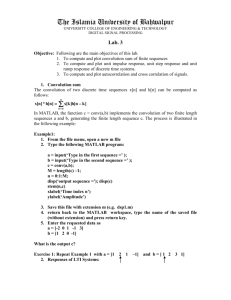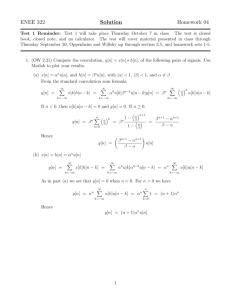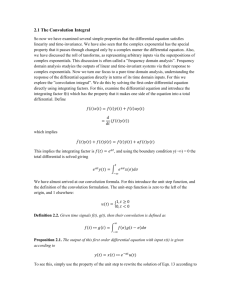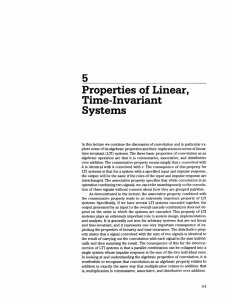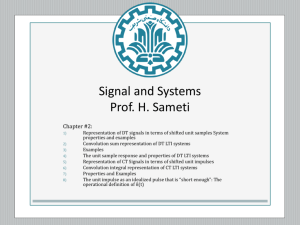File
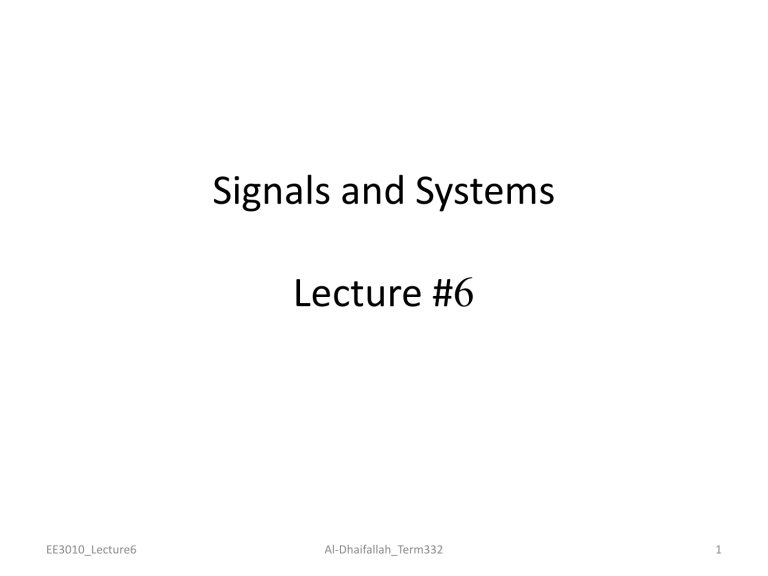
Signals and Systems
Lecture #
6
EE3010_Lecture6 Al-Dhaifallah_Term332 1
Lecture Outlines
1. Representation of DT signals in terms of shifted unit samples ( Last Lecture )
2. Convolution sum representation of DT LTI systems ( Last Lecture )
3. Examples ( Today )
4. The unit sample response and properties of
DT LTI systems ( Today )
EE3010_Lecture6 Al-Dhaifallah_Term332 2
Examples of Convolution and DT LTI Systems
EE3010_Lecture6 Al-Dhaifallah_Term332 3
Examples
EE3010_Lecture6 Al-Dhaifallah_Term332 4
System Identification and Prediction
Note that the system’s response to an arbitrary input signal is completely determined by its response to the unit impulse.
Therefore, if we need to identify a particular LTI system, we can apply a unit impulse signal and measure the system’s response.
That data can then be used to predict the system’s response to any input signal x [ n ] y [ n ]
System: h [ n ]
Note that describing an LTI system using h[n], is equivalent to a description using a difference equation. There is a direct mapping between h [ n ] and the parameters/order of a difference equation such as:
y[n] = x[n] + 0.5x[n-1] + 0.25x[n-2]
EE3010_Lecture6 Al-Dhaifallah_Term332 5
Example 4: LTI Convolution
Consider a LTI system with the following unit impulse response:
h[n] = [0 0 1 1 1 0 0]
For the input sequence:
x[n] = [0 0 0.5 2 0 0 0]
The result is:
y[n] = … + x[0]h[n] + x[1]h[n-1] + …
= 0 +
0.5*[0 0 1 1 1 0 0] +
2.0*[0 0 0 1 1 1 0] +
0
= [0 0 0.5 2.5 2.5 2 0]
EE3010_Lecture6 Al-Dhaifallah_Term332 6
Example 5: LTI Convolution
Consider the problem described for example 4
Sketch x[k] and h[n-k] for any particular value of n, then multiply the two signals and sum over all values of k.
For n<0, we see that x[k]h[n-k] = 0 for all k, since the non-zero values of the two signals do not overlap.
y[0] =
S k
x[k]h[0-k] = 0.5
y[1] =
S k
x[k]h[1-k] = 0.5+2
y[2] =
S k
x[k]h[2-k] = 0.5+2
y[3] =
S k
x[k]h[3-k] = 2
As found in Example 4
EE3010_Lecture6 Al-Dhaifallah_Term332 7
Example 6: LTI Convolution
Consider a LTI system that has a step response h[n] = u[n] to the unit impulse input signal
What is the response when an input signal of the form
x[n] = a n u[n] where 0< a
<1, is applied?
For n
0: y [ n ]
k n
0 a k
1
a
1
a n
1
Therefore, y [ n ]
1
1 a
a n
1
u [ n ]
EE3010_Lecture6 Al-Dhaifallah_Term332 8
The Commutative Property of Convolution
EE3010_Lecture6 Al-Dhaifallah_Term332 9
The Distributive Property of Convolution
EE3010_Lecture6 Al-Dhaifallah_Term332 10
Example: Distributive Property
Let y[n] denote the convolution of the following two sequences: x [ n ]
0 .
5 n u [ n ]
2 n u [
n ] h [ n ]
u [ n ]
x[n] is non-zero for all n. We will use the distributive property to express y[n] as the sum of two simpler convolution problems. Let x
1
[n] = 0.5
= 2 n u[-n], it follows that y [ n ]
( x
1
[ n ]
x
2
[ n ]) * h [ n ] n u[n], x
2
[n] and y[n] = y
1
[n]+y
2
[n], where y
1
[n] = x
1
[n]*h[n], y
1
[n] = x
1
[n]*h[n].
From example 6, and O&W example 2.5
y
1
[ n ]
1
1
0 .
5 n
1
0 .
5
u [ n ]
CISE315 SaS, L13 y n
2
[ ]
2 n
1
2 n
0 n
0
11/19
The Associative Property of Convolution
EE3010_Lecture6 Al-Dhaifallah_Term332 12
Properties of Convolution
EE3010_Lecture6 Al-Dhaifallah_Term332 13
LTI System Memory
An LTI system is memoryless if its output depends only on the input value at the same time, i.e.
y [ n ]
kx [ n ] y ( t )
kx ( t )
For an impulse response, this can only be true if h [ n ]
h ( t )
k
[ n ] k
( t )
Such systems are extremely simple and the output of dynamic engineering, physical systems depend on:
• Preceding values of x[n-1], x[n-2], …
• Past values of y[n-1], y[n-2], … for discrete-time systems, or derivative terms for continuoustime systems
14/19
CISE315 SaS, L14
System Invertibility
Does there exist a system with impulse response h
1
(t) such that
y(t)=x(t)?
x ( t ) w ( t ) y ( t ) h ( t ) h
1
( t )
Widely used concept for:
• control of physical systems, where the aim is to calculate a control signal such that the system behaves as specified
• filtering out noise from communication systems, where the aim is to recover the original signal x(t)
The aim is to calculate “inverse systems” such that h n
h n
1
n h t
h t
1
t
The resulting serial system is therefore memoryless
15/19
CISE315 SaS, L14
Example: Accumulator System
Consider a DT LTI system with an impulse response
h[n] = u[n]
Using convolution, the response to an arbitrary input x[n]:
y [ n ]
x [ k ] h [ n
k ] k
As u[n-k] = 0 for n-k<0 and 1 for n-k
0, this becomes n y [ n ]
x [ k ] k
i.e. it acts as a running sum or accumulator. Therefore an inverse system can be expressed as: y [ n ]
x [ n ]
x [ n
1 ]
A first difference (differential) operator, which has an impulse response h
1
[ n ]
[ n ]
[ n
1 ]
16/19
CISE315 SaS, L14
Causality for LTI Systems
Remember, a causal system only depends on present and past values of the input signal. We do not use knowledge about future information.
For a discrete LTI system, convolution tells us that
h[n] = 0 for n<0 as y[n] must not depend on x[k] for k>n, as the impulse response must be zero before the pulse!
n x [ n ] * h [ n ]
x [ k ] h [ k
n
k ] x ( t ) * h ( t )
t
x (
) h ( t
) d
Both the integrator and its inverse in the previous example are causal
This is strongly related to inverse systems as we generally require our inverse system to be causal. If it is not causal, it is difficult to manufacture!
17/19
CISE315 SaS, L14
LTI System Stability
Remember: A system is stable if every bounded input produces a bounded output
Therefore, consider a bounded input signal
|x[n]| < B for all n
Applying convolution and taking the absolute value: y [ n ]
k
h [ k ] x [ n
k ]
Using the triangle inequality (magnitude of a sum of a set of numbers is no larger than the sum of the magnitude of the numbers):
y [ n ]
h [ k ] x [ n
k ] k
B k
h [ k ]
Therefore a DT LTI system is stable if and only if its impulse response is absolutely summable, ie
h [ k ]
k
Continuous-time system
h (
) d
18/19
CISE315 SaS, L15
Example: System Stability
Are the DT and CT pure time shift systems stable?
h [ n ] h ( t )
[ n
( t
n
0
]
t
0
) k
h [ k ]
k
[ k
n
0
]
1
h (
) d
(
t
0
) d
1
Therefore, both the CT and DT systems are stable : all finite input signals produce a finite output signal
Are the discrete and continuous-time integrator systems stable?
h [ n ] h ( t )
u [ n u ( t
n
0
]
t
0
) k
h [ k ]
k
u [ k
n
0
]
k
n
0 u [ k ]
Therefore, both the CT and DT systems are unstable : at least
h (
) d
u (
t
0
) d
t
0 u (
) d
one finite input causes an infinite output signal
19/19
CISE315 SaS, L15
EE3010_Lecture6 Al-Dhaifallah_Term332 20
Summary
• Any discrete LTI system can be completely determined by measuring its unit impulse response h [ n ]
This can be used to predict the response to an arbitrary input signal using the convolution operator: y [ n ]
x [ k ] h [ n
k ] k
• The output signal y [ n ] can be calculated by:
• Sum of scaled signals – example 4
• Non-zero elements of h – example 5
• The two ways of calculating the convolution are equivalent
EE3010_Lecture6 Al-Dhaifallah_Term332 21
Linear Systems and Convolution
• Specific objectives for today:
• We’re looking at continuous time signals and systems
• Understand a system’s impulse response properties
• Show how any input signal can be decomposed into a continuum of impulses
• Convolution
22/10
CISE315 SaS, L10
Lecture: Resources
• Core material
• SaS, O&W, C2.2
CISE315 SaS, L10
23/10
Introduction to “Continuous”
•
Convolution
In this lecture, we’re going to understand how the convolution theory can be applied to continuous systems. This is probably most easily introduced by considering the relationship between discrete and continuous systems.
• The convolution sum for discrete systems was based on the sifting principle, the input signal can be represented as a superposition (linear combination) of scaled and shifted impulse functions.
• This can be generalized to continuous signals, by thinking of it as the limiting case of arbitrarily thin pulses
24/10
CISE315 SaS, L10
Signal “Staircase”
Approximation
• As previously shown, any continuous signal can be approximated by a linear combination of thin, delayed pulses:
( t
D
( t )
D
)
1
D
0
0
t
D otherwise
1/D
D
• Note that this pulse (rectangle) has a unit integral. Then we have: x
^
( t )
x (
k
D
)
D
( t
k
D
)
D k
• Only one pulse is non-zero for any value of t. Then as
D
0
x ( t )
lim
D
0 k x ( k
D
)
D
( t
k
D
)
D
• When
D
0, the summation approaches an integral x ( t )
x (
)
( t
) d
• This is known as the sifting property of the continuous-time impulse and there are an infinite number of such impulses
(t-
)
25/10
CISE315 SaS, L10
Alternative Derivation of Sifting
Property
• The unit impulse function,
(t), could have been used to directly derive the sifting function.
( t
)
0 t
( t
) d
1
• Therefore: x (
)
( t
)
0
x (
)
( t
) d
t
x ( t )
( t x ( t )
( t x ( t )
) d
) d
• The previous derivation strongly emphasises the close relationship between the structure for both discrete and continuous-time signals
26/10
CISE315 SaS, L10
Continuous Time Convolution
• Given that the input signal can be approximated by a sum of scaled, shifted version of the pulse signal,
D
(t-k
D
)
^ x ( t )
k
x ( k
D
)
D
( t
k
D
)
D
• responses, h
^ k
D
^
(t), which is the system response to
D
(t-k
D
).
• From the discrete-time convolution:
^ y ( t )
x ( k
D
) h
^ k
D ( t )
D k
• What remains is to consider as
D
0. In this case: y ( t )
lim
D
0 k
x ( k
D
)
^ h k
D
( t )
D
x (
) h
( t ) d
27/10
CISE315 SaS, L10
Example: Discrete to Continuous
Time Linear Convolution
• The CT input signal (red) x(t) is approximated (blue) by:
^ x ( t )
k
x ( k
D
)
D
( t
k
D
)
D
• Each pulse signal
D
( t
k
D
)
• generates a response
^ h k
D ( t )
• Therefore the DT convolution response is
^
y ( t )
x ( k
D
) h
^ k
D ( t )
D k
• Which approximates the CT convolution response y ( t )
x (
) h
( t ) d
28/10
CISE315 SaS, L10
Linear Time Invariant Convolution
• For a linear, time invariant system, all the impulse responses are simply time shifted versions: h
( t )
h ( t
)
• Therefore, convolution for an LTI system is defined by: y ( t )
x (
) h ( t
) d
• This is known as the convolution integral or the superposition integral
• Algebraically, it can be written as: y ( t )
x ( t ) * h ( t )
• To evaluate the integral for a specific value of t, obtain the signal
h(t-
) and multiply it with x(
) and the value y(t) is obtained by integrating over
from –
to
.
• Demonstrated in the following examples
Example 1: CT Convolution
• Let x(t) be the input to a LTI system with unit impulse response h(t): x ( t )
e
at u ( t ) a
0 h ( t )
u ( t )
• For t>0: x (
) h ( t
)
e
a
0
0
t otherwise
• We can compute y(t) for t>0: y ( t )
1 a
0
t e
a
d
1
e
at
1 a e
a
t
0
• So for all t: y ( t )
1 a
1
e
at
u ( t )
In this example a =1
30/10
CISE315 SaS, L10
Lecture 10: Summary
• A continuous signal x(t) can be represented via the sifting property: x ( t )
x (
)
( t
) d
• Any continuous LTI system can be completely determined by measuring its unit impulse response h(t)
•
( t
) ) d
impulse response, the system’s output can be determined via convolution via
• Note that this is an alternative way of
31/10
ODE. h(t) contains the derivative information
